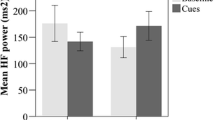Abstract
Alcoholcraving is het vaak sterke en soms overweldigende verlangen om te drinken. Dit fenomeen speelt een belangrijke rol bij de overgang van gecontroleerd drinken naar alcoholafhankelijkheid, de mechanismen die ten grondslag liggen aan terugval en de behandeling van verslaving. In dit artikel wordt een psychobiologisch etiologisch model gepresenteerd, waarbij voor drie verschillende vormen van craving de mogelijke biologische en psychologische wortels worden beschreven.
Similar content being viewed by others
Literatuur
Anton R.F., Moak D.H. & Latham P.K. (1996). The Obsessive Compulsive Drinking Scale: a self-rated instrument for the quantification of thoughts about alcohol and drinking behaviour. Alcoholism Clinical and Experimental Research 19, 92-99.
Breiter H.C., Rauch S.L., Kwong K.K. e.a. (1996). Functional magnetic resonance imaging of symptom provocation in obsessive-compulsive disorder. Archives of General Psychiatry 53, 595-606.
Buydens-Branchey L., Branchey M., Fergeson P. e.a. (1997). Hormonal, psychological, and alcohol craving changes after m-Chlorophenylpiperazine administration in alcoholics. Alcoholism Clinical and Experimental Research 21, 220-227.
Chick J., Howlett H., Morgan M.Y. & Ritson B. (2000). United Kingdom Multicenter Acamprosate Study (ukmas): a 6-month prospective study of acamprosate versus placebo in preventing relapse after withdrawal from alcohol. Alcohol & Alcoholism 35, 176-187.
Cloninger C.R. (1987). Neurogenetic adaptive mechanisms in alcoholism. Science 236, 410-436.
Conrod P.J., Pihl R.O. & Vassileva J. (1998). Differential sensitivity to alcohol reinforcement in groups of men at risk for distinct alcoholism subtypes. Alcoholism Clinical and Experimental Research 22, 585-597.
Cooney N.L., Litt M.D., Morse P.A. e.a. (1997). Alcohol cue reactivity, negative-mood reactivity, and relapse in treated alcoholic men. Journal of Abnormal Psychology 106, 243-250.
Cornelius J.R., Salloum I.M., Ehller J.G., e.a. (1997). Fluoxetine in depressed alcoholics: a double-blind, placebo-controlled trial. Archives of General Psychiatry 54, 700-705.
Cowley D.S., Roy-Byrne P.P., Greenblatt D.J., e.a. (1996). Effect of diazepam on plasma g-aminobutyric acid in sons of alcoholic fathers. Alcoholism Clinical and Experimental Research 20, 343-347.
Depue R.A., Luciana M., Arbisi P. e.a. (1994). Dopamine and the structure of personality: relation of agonist-induced dopamine activity to positive emotionality. Journal of Personality and Social Personality 67, 485-498.
Gerra G., Caccavari R., Delsignore R. e.a. (1992). Effects of fluoxetine and Ca-Acetyl-Homotaurniate on alcohol intake in familial and nonfamilial alcoholic patients. Current Therapeutic Research 52, 291-295.
Gerra G., Ferri M., Zaimovic A. e.a. (1998). GABAergic function in detoxified heroin addicts: relationship to anxiety disorders. Psychiatry Research 77, 89-96.
Gianoulakis C. (1996). Implications of endogenous opioids and dopamine in alcoholism: human and basic science studies. Alcohol & Alcoholism 31, 33-42.
Goodman W.K., Price L.H., Delgado P.L. e.a. (1990). Specificity of serotonin reuptake inhibitors in the treatment of obsessive-compulsive disorders. Archives of General Psychiatry 47, 577-585.
Goodwin D.W. (1985). Alcoholics and genetics: the sins of the fathers. Archives of General Psychiatry 42, 171-174.
Grant S., London E.D., Newlin D.B. e.a. (1996). Activation of memory circuits during cue-elicited cocaine craving. Proceedings of the National Academy of Sciences USA 93, 12040-12045.
Hill S.Y., Locke J., Zezza N. e.a. (1998). Genetic association between reduced P300 amplitude and the drd2 dopamine receptor A1 allele in children at high risk for alcoholism. Biological Psychiatry 43, 40-51.
Hollander E., DeCaria C.M., Nitescu A. e.a. (1992). Serotonergic function in obsessive-compulsive disorder. Archives of General Psychiatry 49, 21-28.
King A.C., Volpicelli J.R., Frazer A. & O'Brien C.P. (1997). Effect of naltrexone on subjective alcohol response in subjects at high and low risk for future alcohol dependence. Psychopharmacology 129, 15-22.
Koeter M.W.J., Brink W. van den & Hartgers C. (1995). Cloninger's type I and II alcoholics among treated alcoholics: prevalence and validity of the construct. European Addiction Research 1, 187-193.
Lesch O.M. & Walter H. (1996). Subtypes of alcoholism and their role in therapy. Alcohol & Alcoholism 31 (supplement), 63-67.
Maas L.C., Lukas S.E., Kaufman M.J. e.a. (1998). Functional magnetic resonance imaging of human brain activation during cue-induced cocaine craving. American Journal of Psychiatry 155, 124-126.
Monti P.M., Rohsenow D.J., Hutchison K.E. e.a. (1999). Naltrexone's effect on cue-elicited craving among alcoholics in treatment. Alcoholism Clinical and Experimental Research 23, 1386-1394.
Naranjo C.A., Sellers E.M., Jullivan J.T. e.a. (1987). The serotonin uptake inhibitor citalopram attenuates ethanol intake. Clinical Pharmacological Therapy 41, 266-274.
Niaura R.S., Rohsenow D.J., Binkoff J.A. e.a. (1988). Relevance of cue reactivity to understanding alcohol and smoking relapse. Journal of Abnormal Psychology 97, 133-152.
Praag H.M. van (1990). Two-tier diagnosing in psychiatry. Psychiatry Research 34, 1-11.
Robinson T.E. & Berridge K.C. (1993). The neural basis of craving: an incentive-sensitization theory of addiction. Brain Research Review 18, 247-291.
Samson H.H. & Harris R.A. (1992). The neurobiology of alcohol abuse. Trends in Pharmacological Sciences 13, 206-211.
Siever L.J. & Davis K.L. (1991). A psychobiological perspective on the personality disorders. American Journal of Psychiatry 148, 1647-1658.
Spanagel R. & Zieglgänsberger W. (1997). Anti-craving compounds for ethanol: new pharmacological tools to study addictive processes. Trends in Pharmacological Sciences 18, 54-59.
Tiffany S.T. (1990). A cognitive model of drug urges and drug-use behavior: role of automatic and nonautomatic processes. Psychological Review 97, 147-168.
Tsai G.E., Ragan P., Chang R. e.a. (1998). Increased glutamatergic neurotransmission and oxidative stress after alcohol withdrawal. American Journal of Psychiatry 155, 726-732.
Verheul R., Brink W. van den & Geerlings P.J. (1999). A three-pathway psychobiological model of craving for alcohol. Alcohol & Alcoholism 34, 197-222.
Verkes R.J. (1998). The low serotonin syndrome in recurrent suicidal behaviour (dissertation). Universiteit Leiden.
Volpicelli J.R. (1987). Uncontrollable events and alcohol drinking. British Journal of Addiction 82, 381-392.
Wand G.S., Mangold D., El-Deiry S. e.a. (1998). Family history of alcoholism and hypothalamic opoidergic activity. Archives of General Psychiatry 55, 1114-1119.
World Health Organization (1992). De icd-10 Classificatie van psychische stoornissen en gedragsstoornissen: klinische beschrijvingen en diagnostische richtlijnen. Lisse, Swets & Zeitlinger.
Author information
Authors and Affiliations
Rights and permissions
About this article
Cite this article
Verheul, R. Craving: tussen de biologie en psychologie van alcoholafhankelijkheid. NEPR 4, 123–129 (2000). https://doi.org/10.1007/BF03078980
Issue Date:
DOI: https://doi.org/10.1007/BF03078980




